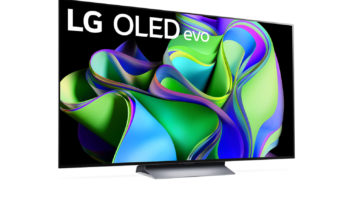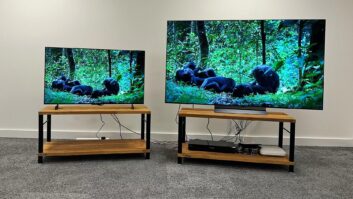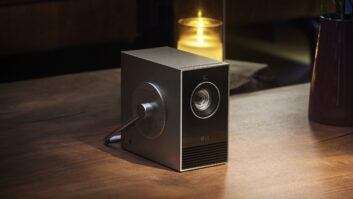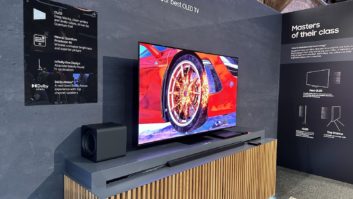LAS VEGAS – Wandering around LG’s International CES booth this week, it won’t be hard to imagine a future in which OLED TVs, with their stygian blacks, popping colors and pencil thinness, become the standard of modern living rooms.
That is, until you leave the LG booth and see how few non-LG OLED TV models are on display. Not only is LG displaying the widest selection of OLED TVs at the show, it’s the only company currently selling multiple big-screen models, and some at surprisingly low prices for such a new technology.
Last August, for instance, LG introduced its popularly reviewed 55-inch 55EC9300 2K OLED at just $3,500 – a 76 percent drop in price from the company’s previous-generation model, and a third the price of Samsung’s lone 2014 55-inch OLED model. Here at CES, LG will be exhibiting eight 4K Ultra HD OLED models and a single FullHD carry over model. (See report on LG’s TV ).
Thus far, LG remains the solitary OLED purveyor and proselytizer because it has developed and scaled mass-production processes for its WRGB OLED technology, which was acquired from original inventor Eastman Kodak, said Paul Gray, principal analyst at IHS/DisplaySearch.
While making breakthroughs in organic photovoltaics OPV (used in solar panels) in 1980, Kodak researcher Ching Tang discovered he could create electroluminescence by passing low voltage through organic thin films. By the end of the decade, Tang and his research partner, Steve Van Slyke, had perfected the technology.
Kodak’s approach – which was originally called White OLED (WOLED) before LG changed it to White RGB (or WRGB) – essentially starts with a white emitter (technically blue+yellow), which is then overlaid with a color filter to achieve the red, green and blue (RGB) palette.
It took LG nearly a decade to develop and perfect WRGB technology and its manufacturing process.
In comparison, LG’s Korean bête noire, Samsung, has pursued a more direct RGB AMOLED approach, which uses separate red, green and blue organic emitters.
Gray said in terms of degree of difficulty, LG’s WRGB method is “like a shot to the moon,” where Samsung’s RGB AMOLED “is a shot to Mars.”
Then adding 4K UHD to the mix is an interstellar voyage.
For big-screen TVs, LG’s WRGB approach is the more easily manufactured method.
Today, Gray said, LG’s manufacturing yield for big-screen WRGB is around 80 percent, which has helped the company quickly ratchet down pricing.
“If OLED yields can be improved, [the LCD v. OLED equation] changes dramatically,” Gray said.
OLED becomes economically viable even at “only” 60 percent yield because OLED’s “optical components are well over half the cost of an LCD,” Gray noted. So, boost yield to more than half and you reach something like a manufacturing cost parity with LCD UHD.
Being able to reach a $3,500 price means OLED “will be price compatible with LCD at some point,” according to Tim Alessi, LG Electronics USA’s head of new product development. This puts LG years ahead of any other OLED supplier.
Samsung, meanwhile, continues to develop and refine its RGB AMOLED manufacturing process, after abandoning a Fine Metal Mask (FMM) large screen OLED manufacturing method, which is sort of like a fancy stencil onto which red, green and blue color phosphors are laid onto the glass or plastic panel. At larger sizes, this fine metal mask is prone to warping.
Instead, Samsung switched to an alternative method called Small Mask Scanning (SMS), which uses, three smaller metal masks, each dedicated to a single color.
Even though Samsung was able to bring yields up to 80 percent using SMS, the company still found the process too expensive. In late 2013, the company started casting about for a new mass-manufacturing process.
In late September, Samsung made a multimillion dollar investment in an MIT spinoff start-up called Kateeva, whose chief technology officer is Kodak’s WOLED co-inventor Steve Van Slyke. Kateeva has perfected an OLED inkjet printing technology for manufacturing called Yieldjet that could replace the current inefficient vacuum thermal evaporation (VTE) method for laying organic materials onto the plastic or glass panels (and Samsung’s SMS system), which wastes up to 95 percent of the organic materials.
But OLED experts believe it will take time to make the Yieldjet technology mass production ready, due to a shorter lifespan for the organic material solution (the ink) used in the inkjet printing process. In the meantime, Samsung has decided to pursue the potential of quantum dot LCD technology.
Meanwhile, Sony and Panasonic are even further behind their Korean competitors. Rather than go it alone, the pair decided to pool their respective resources with the Japanese government to come up with a national OLED solution.
According to Gray, the bottom line is that it’ll likely take at least three to five years before Samsung can start to effectively compete with LG, and longer than that for Sony and Panasonic.
Meanwhile, LG will continue to exploit its OLED advantage. It’s building a South Korean plant with a projected capacity of 150,000 big-screen OLED sets a month. These economies of scale will help LG’s OLEDs reach LCD price parity quicker, perhaps in less than two years, and it is already licensing its OLED technology and/or supplying panels to Chinese makers such as TCL and Hisense.
LG continues to tout OLED as the “future of television,” the third major display breakthrough after monochrome-to-color and CRT-to-flat-screen.
But that might necessitate more than one manufacturer championing the cause. As weird as it may sound, LG might benefit more by either licensing its WRGB technology to other TV makers or by rooting for other TV brands to catch up quickly in order to establish a broader OLED marketplace. Otherwise, with the threat of quantum dot LCD and other technologies looming, OLED could become another niche high-performance display technology – like plasma TV













